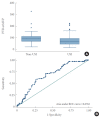Clinical and Urodynamic Predictors of the Q-Tip Test in Women With Lower Urinary Tract Symptoms
- PMID: 32252186
- PMCID: PMC7136438
- DOI: 10.5213/inj.1938156.078
Clinical and Urodynamic Predictors of the Q-Tip Test in Women With Lower Urinary Tract Symptoms
Abstract
Purpose: The Q-tip test is used to measure urethral hypermobility and can predict surgical outcomes. However, certain factors may affect the reliability of this test. Our aim was to identify independent clinical and urodynamic predictors of the results of the Q-tip test.
Methods: Between January 2014 and June 2019, 176 consecutive women with lower urinary tract symptoms who underwent the Q-tip test and urodynamic studies were included in this retrospective study.
Results: Multivariable regression analysis revealed that age (regression coefficient, -0.55), point Ba (regression coefficient, 4.1), urodynamic stress incontinence (regression coefficient, 9.9), maximum flow rate (Qmax) (regression coefficient, 0.13), pressure transmission ratio (PTR) at maximum urethral pressure (MUP) (regression coefficient, -0.14), and the score on the fifth question of the Incontinence Impact Questionnaire (IIQQ5; "Has urine leakage affected your participation in social activities outside your home?"; regression coefficient, -4.1) were independent predictors of the Q-tip angle, with a constant of 87.0. The following Spearman rank correlation coefficients were found between the Q-tip angle and the following variables: age, -0.38; point Ba, 0.34; urodynamic stress incontinence, 0.32; Qmax, 0.28; PTR at MUP, -0.28; and IIQQ5, -0.23. A receiver operating characteristic curve (ROC) analysis for the prediction of urodynamic stress incontinence found that the optimum cutoff for PTR at MUP was <81%, with an area under the ROC curve of 0.70.
Conclusion: Age, point Ba, urodynamic stress incontinence, Qmax, PTR at MUP, and IIQQ5 were independent predictors of the Q-tip angle. However, none of these could be used as effective surrogates for the Q-tip test due to their lack of a sufficient correlation.
Keywords: Pelvic organ prolapse; Urinary bladder, Overactive; Urinary incontinence, Stress; Urodynamics.
Conflict of interest statement
No potential conflict of interest relevant to this article was reported.
Figures


Similar articles
-
Clinical and urodynamic predictors of Q-tip test urethral hypermobility.Minerva Obstet Gynecol. 2022 Apr;74(2):155-160. doi: 10.23736/S2724-606X.21.04766-3. Epub 2021 Apr 20. Minerva Obstet Gynecol. 2022. PMID: 33876905
-
Clinical and demographic factors associated with valsalva leak point pressure among women undergoing burch bladder neck suspension or autologous rectus fascial sling procedures.Neurourol Urodyn. 2007;26(3):392-6. doi: 10.1002/nau.20325. Neurourol Urodyn. 2007. PMID: 17304525 Clinical Trial.
-
Can we predict urinary stress incontinence by using demographic, clinical, imaging and urodynamic data?Eur J Obstet Gynecol Reprod Biol. 2015 Oct;193:114-7. doi: 10.1016/j.ejogrb.2015.07.012. Epub 2015 Jul 31. Eur J Obstet Gynecol Reprod Biol. 2015. PMID: 26291686
-
[Recommendations for the urodynamic examination in the investigation of non-neurological female urinary incontinence].Prog Urol. 2007 Nov;17(6 Suppl 2):1264-84. Prog Urol. 2007. PMID: 18214138 Review. French.
-
Urodynamic assessment of patients with stress incontinence: how effective are urethral pressure profilometry and abdominal leak point pressures at case selection and predicting outcome?Curr Opin Urol. 2004 Nov;14(6):307-11. doi: 10.1097/00042307-200411000-00002. Curr Opin Urol. 2004. PMID: 15626870 Review.
Cited by
-
Add-On Effect of Postural Instructions to Abdominopelvic Exercise on Urinary Symptoms and Quality of Life in Climacteric Women with Stress Urinary Incontinence. A Pilot Randomized Controlled Trial.Int J Environ Res Public Health. 2021 Jan 21;18(3):928. doi: 10.3390/ijerph18030928. Int J Environ Res Public Health. 2021. PMID: 33494479 Free PMC article. Clinical Trial.
References
-
- Crystle CD, Charme LS, Copeland WE. Q-tip test in stress urinary incontinence. Obstet Gynecol. 1971;38:313–5. - PubMed
-
- Kim SO, Jung HS, Jang WS, Hwang IS, Yu HS, Kwon D. Measurement of the Q-tip angle before and after tension-free vaginal tapeobturator (TVT-O): preoperative urethral mobility may predict surgical outcome. Int Urogynecol J. 2013;24:1005–9. - PubMed
-
- Toledo LG, Cabral PH, Casella ML, Politi GE, Cardoso SN, Mello LF, et al. Prognostic value of urethral mobility and valsalva leak point pressure for female transobturator sling procedure. Int Braz J Urol. 2012;38:667–73. - PubMed
-
- Bakas P, Liapis A, Creatsas G. Q-tip test and tension-free vaginal tape in the management of female patients with genuine stress incontinence. Gynecol Obstet Invest. 2002;53:170–3. - PubMed
-
- Swift S, Barnes D, Herron A, Goodnight W. Test-retest reliability of the cotton swab (Q-tip) test in the evaluation of the incontinent female. Int Urogynecol J. 2010;21:963–7. - PubMed
Grants and funding
LinkOut - more resources
Full Text Sources

